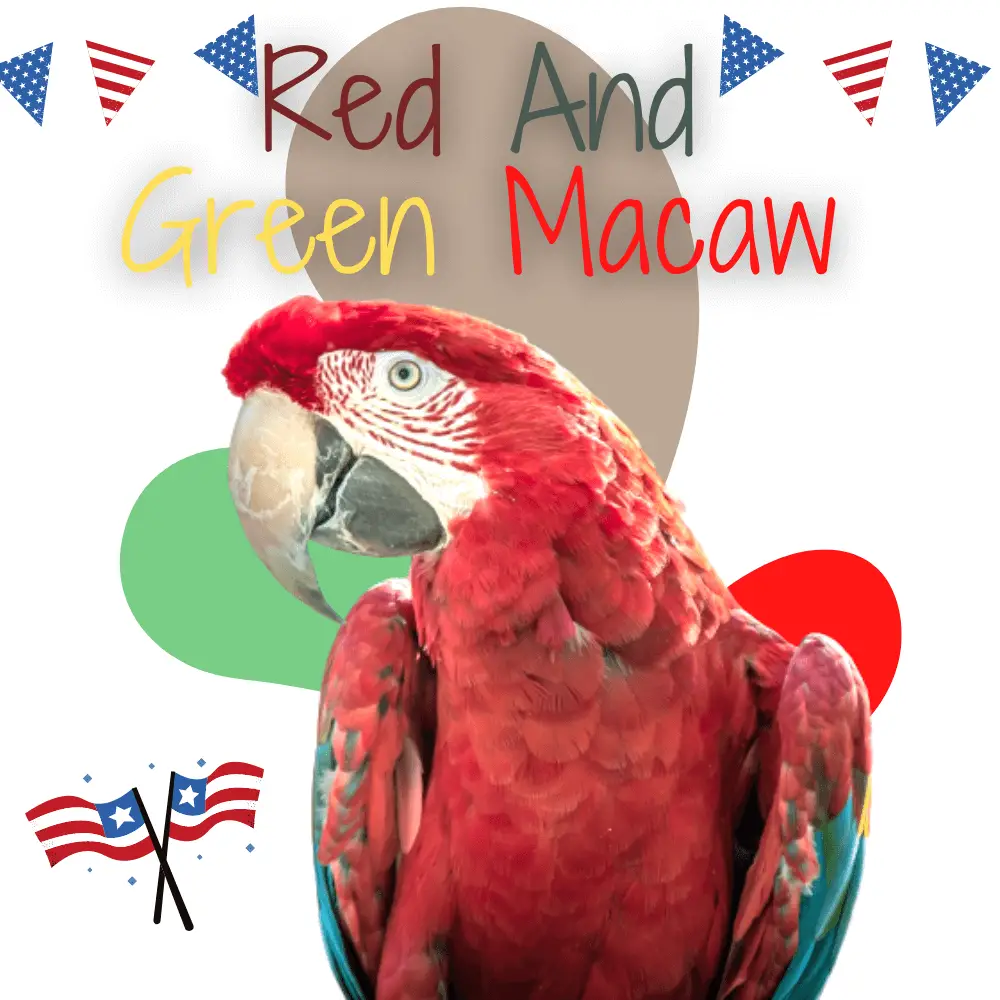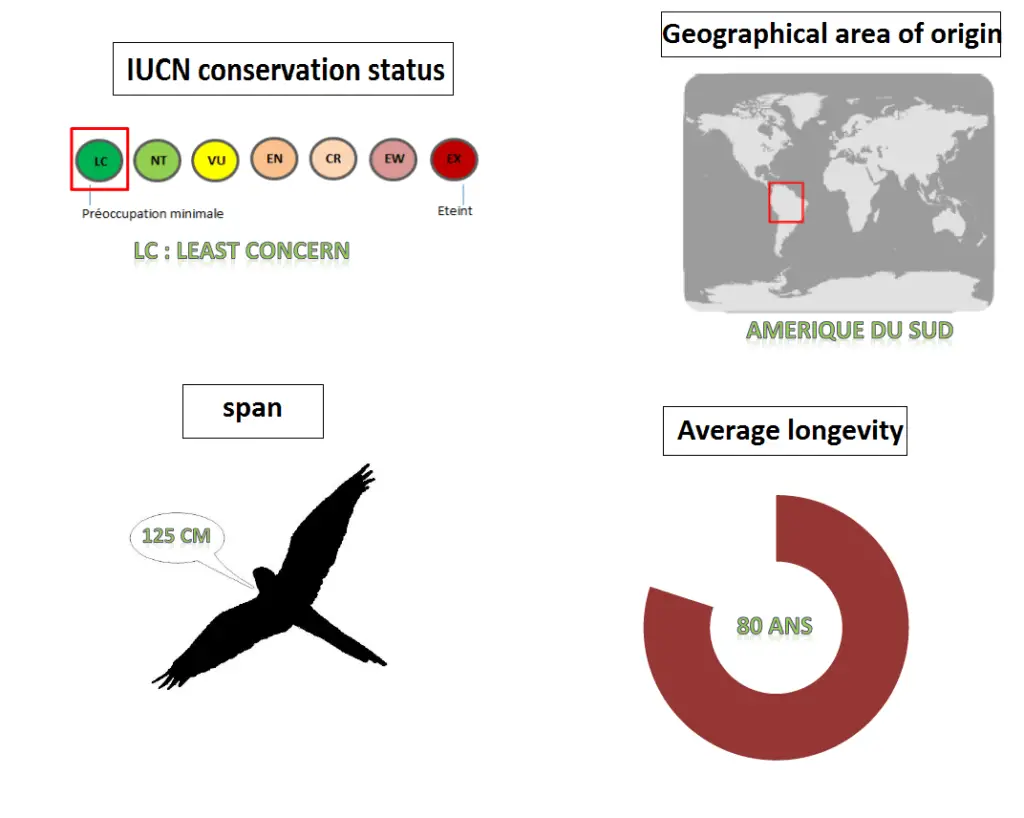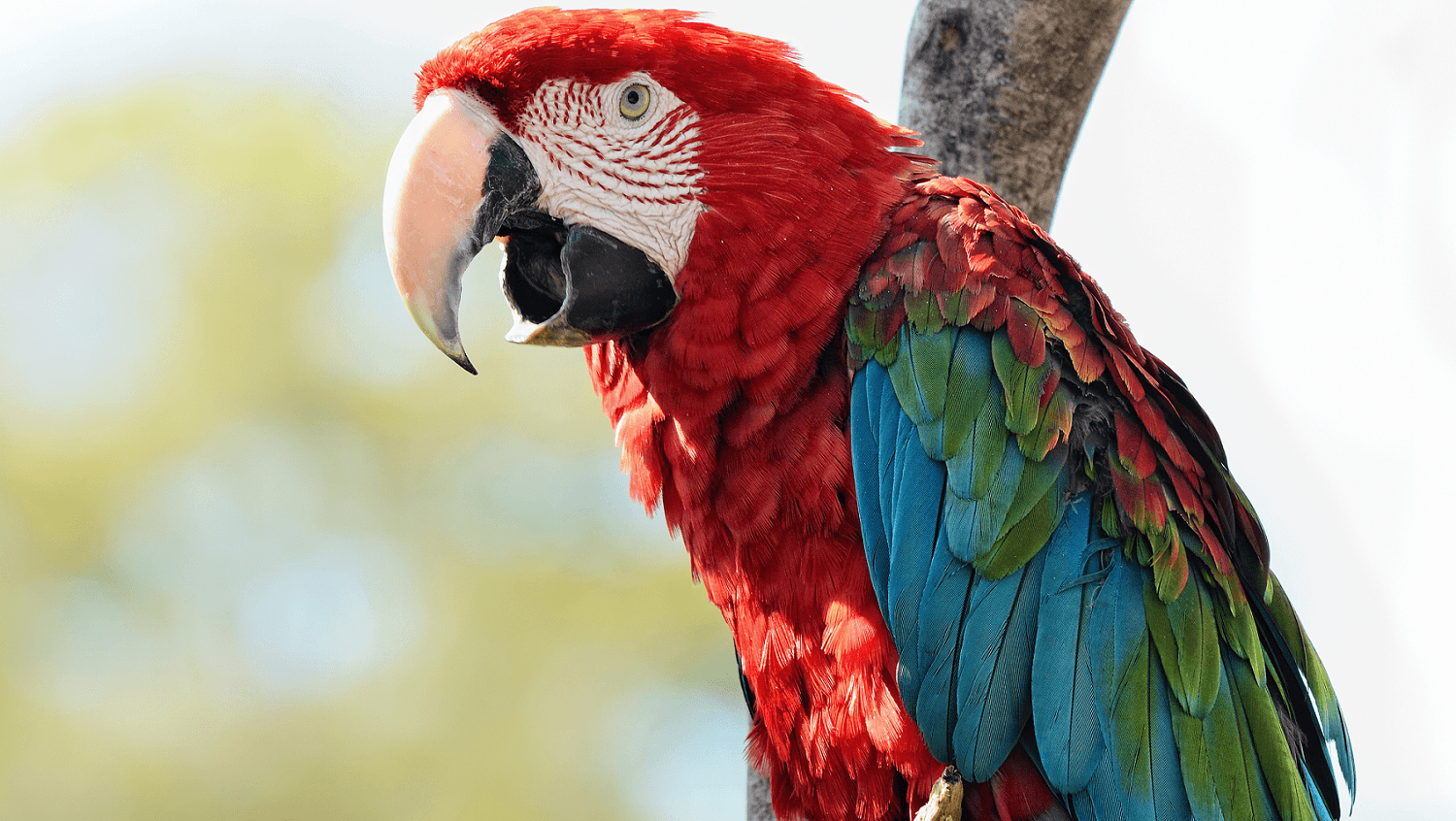
Red and green macaw Ara ararauna-chloropterus
Order: Psittaciformes
Family: Psittacidae
CITES Appendix II, freeholding not subject to quotas
Sex: No sexual dimorphism
Phenotype:
- Large parrots characterized by very long blue and red caudals
- Redbelly, head and neck, back and dorsal sides of green and red wings, blue feathers and rim-red eyes around the eyes
Character: cf. Ara blue and yellow macaw (Ara ararauna)
Weight: 990 – 1300 g
Ara ararauna-chloropterus
Red and green macaw Ara ararauna-chloropterus

Red and green macaw Ara ararauna-chloropterus In adults, the head and a large part of the body are scarlet red. The nape and the top of the coat are shiny red.
The feathers of the lower mantle are red with yellow tips while those of the scapulars are yellow with green endings. The back and the upper caudals display a bright blue color.
The lower covers are shiny red, contrasting with the medium covers which are yellow with more or less wide green borders. The primary covers and the alula are blue.
Flight feathers are blue above, olive-green, and red below. The axillaries and the underside of the wings are red. The lower parts of the throat up to the belly have a shiny red set which contrasts with the pale blue undertail.
The central rectrices above the tail are red with pale blue tips. The external rectifiers are blue. The underside of the tail is mostly red.
The strongly curved upper mandible displays a horn color with a black tip. The massive lower mandible is entirely blackish.
The bare skin of the lores and cheeks is whitish but takes on a pinkish shade during the moments of excitement. The irises are yellow. The legs are charcoal black.
Sub-specific indications 2 subspecies
The Scarlet Macaw utters screeching and dry cries which include “rrraaaaaa”, powerful and squeaky “reck” as well as “rowwwwka”. These calls are generally more stretched than those of the Scarlet Macaw, but they are quite difficult to differentiate.
In addition to these different calls, he has a varied repertoire of screeches, hoarse and guttural cries, and prolonged grunts. Relaxed birds make quieter calls, including a sound that sounds like the sound of a creaking door.
Habitat

Red-and-green macaw
Adult macaw
The Scarlet Macaw is very tolerant of habitats, so it is found in many types of wooded areas.
In Central America, it frequents rather deciduous tree forests and sparse afforestation, including the mountainous edges of pine plots. In this part of its territory, it willingly gives way to Buffon’s macaw (Ara ambigua) in wet habitats.
In the Amazon and in the Guyanas, it frequents forests that are not invaded by water, leaving the areas liable to flooding to blue macaws (Ara ararauna).
The Scarlet Macaw also settles in gallery forests bordering rivers, in pastures, and on agricultural land where there are a few scraps of a residual forest.
Character traits behavior
The Scarlet Macaw is a noisy bird and fairly easy to observe. He has gregarious mores, which makes it possible to meet him as a couple, in a small family group or in a band that can usually count up to twenty individuals.
Scarlet macaw
However, larger gatherings can be attracted by the abundance of food resources on clay soils or earth banks. The Scarlet Macaw is familiar when it is not disturbed.
However, usually, he is quite careful and he rises in the air with a piercing cry when disturbed. Early in the morning and late at night, the scarlet macaw flies dramatically between its resting place and its feeding site. Paired couples always fly together, their wings almost touching.
The Scarlet Macaw is arboreal: it feeds and rests on the upper floor or at the tops of large trees. Its flight is direct, its wingbeats are regular but lack amplitude.
This species is sedentary, which does not prevent it from performing short migrations when the food begins to lack.
SOURCE:AnimalWonders Montana
Food mode and diet
Scarlet macaws or Red-and-green macaw are exclusively vegetarian. They feed on fruits, palm nuts, and seeds. In Central America, they feed in the pines, crushing the cones and dropping a shower of scales at the foot of the trunks.
When food is plentiful, Scarlet Macaws commonly feed with other species of parrots.
Reproduction nesting
The breeding season varies from region to region: it takes place in March in Mexico, in April in Nicaragua, from October to April in Costa Rica.
Ara rougeadulteElle or Red-and-green macaw takes place in March in French Guiana, from October to March in central Brazil, and from November to April in Peru.
The nest is placed in a large natural cavity, between 7 and 40 meters above the ground. In Peru, the couple usually chooses a palm of the genus Iriarthea,
but they must leave the Brazilian teaks (Dipteryx) and the other hardwoods to the macaw’s chloroprene that dominate them. The laying includes 1 to 4 eggs which are incubated between 24 and 28 days.
The chicks stay in the nest for about 14 weeks. In a recent study, 9 out of 14 nests successfully produced one or more eggs. On 21 chicks
hatched, 10 reached flight, 4 died of malnutrition, and 7 were victims of predators, a success rate slightly less than 50%.
Distribution
The Scarlet Macaw or Red-and-green macaw is endemic to Central America and northern South America. In Central America, this bird occurs from southeastern Mexico to northeastern Nicaragua and from Costa Rica to Panama.
In northern Colombia, an isolated population occupies the Magdalena Valley. The main part of its area is located on the South American continent, covering the entire Amazon from Venezuela and Guyana to Ecuador, Peru, Bolivia. It extends across all of Brazil to the north of Mato Grosso.
The Scarlet Macaw or Red-and-green macaw is a bird from the lower regions. It is generally found below 500 m above sea level, although it can sometimes climb up to 1000 meters.
The Red-and-green macaw has 2 subspecies: A.m. Macao, the nominal breed, (from Costa Rica to South America) – A.m. cyanoptera (from southeastern Mexico to Belize and Nicaragua).
In Central America, the species has suffered a dramatic decline due to deforestation, severe habitat modification, and its commercialization as a caged bird.
In many areas, it has become rare and in other places, it has simply disappeared. In 2003, the total population of Belize was estimated at less than 150 birds.
Elsewhere, and especially in South America, the macaw is locally common, but it is found in very small numbers near human settlements or groups. Given the large area of its distribution area, the species is however classified as not presenting any major problem. (LC).




















